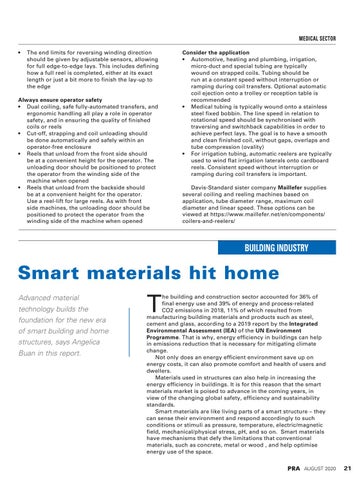Medical Sector • The end limits for reversing winding direction should be given by adjustable sensors, allowing for full edge-to-edge lays. This includes defining how a full reel is completed, either at its exact length or just a bit more to finish the lay-up to the edge Always ensure operator safety • Dual coiling, safe fully-automated transfers, and ergonomic handling all play a role in operator safety, and in ensuring the quality of finished coils or reels • Cut-off, strapping and coil unloading should be done automatically and safely within an operator-free enclosure • Reels that unload from the front side should be at a convenient height for the operator. The unloading door should be positioned to protect the operator from the winding side of the machine when opened • Reels that unload from the backside should be at a convenient height for the operator. Use a reel-lift for large reels. As with front side machines, the unloading door should be positioned to protect the operator from the winding side of the machine when opened
Consider the application • Automotive, heating and plumbing, irrigation, micro-duct and special tubing are typically wound on strapped coils. Tubing should be run at a constant speed without interruption or ramping during coil transfers. Optional automatic coil ejection onto a trolley or reception table is recommended • Medical tubing is typically wound onto a stainless steel fixed bobbin. The line speed in relation to rotational speed should be synchronised with traversing and switchback capabilities in order to achieve perfect lays. The goal is to have a smooth and clean finished coil, without gaps, overlaps and tube compression (ovality) • For irrigation tubing, automatic reelers are typically used to wind flat irrigation laterals onto cardboard reels. Consistent speed without interruption or ramping during coil transfers is important. Davis-Standard sister company Maillefer supplies several coiling and reeling machines based on application, tube diameter range, maximum coil diameter and linear speed. These options can be viewed at https://www.maillefer.net/en/components/ coilers-and-reelers/
Building Industry
Smart materials hit home Advanced material technology builds the foundation for the new era of smart building and home structures, says Angelica Buan in this report.
T
he building and construction sector accounted for 36% of final energy use and 39% of energy and process-related CO2 emissions in 2018, 11% of which resulted from manufacturing building materials and products such as steel, cement and glass, according to a 2019 report by the Integrated Environmental Assessment (IEA) of the UN Environment Programme. That is why, energy efficiency in buildings can help in emissions reduction that is necessary for mitigating climate change. Not only does an energy efficient environment save up on energy costs, it can also promote comfort and health of users and dwellers. Materials used in structures can also help in increasing the energy efficiency in buildings. It is for this reason that the smart materials market is poised to advance in the coming years, in view of the changing global safety, efficiency and sustainability standards. Smart materials are like living parts of a smart structure – they can sense their environment and respond accordingly to such conditions or stimuli as pressure, temperature, electric/magnetic field, mechanical/physical stress, pH, and so on. Smart materials have mechanisms that defy the limitations that conventional materials, such as concrete, metal or wood , and help optimise energy use of the space. AUGUST 2020
21
